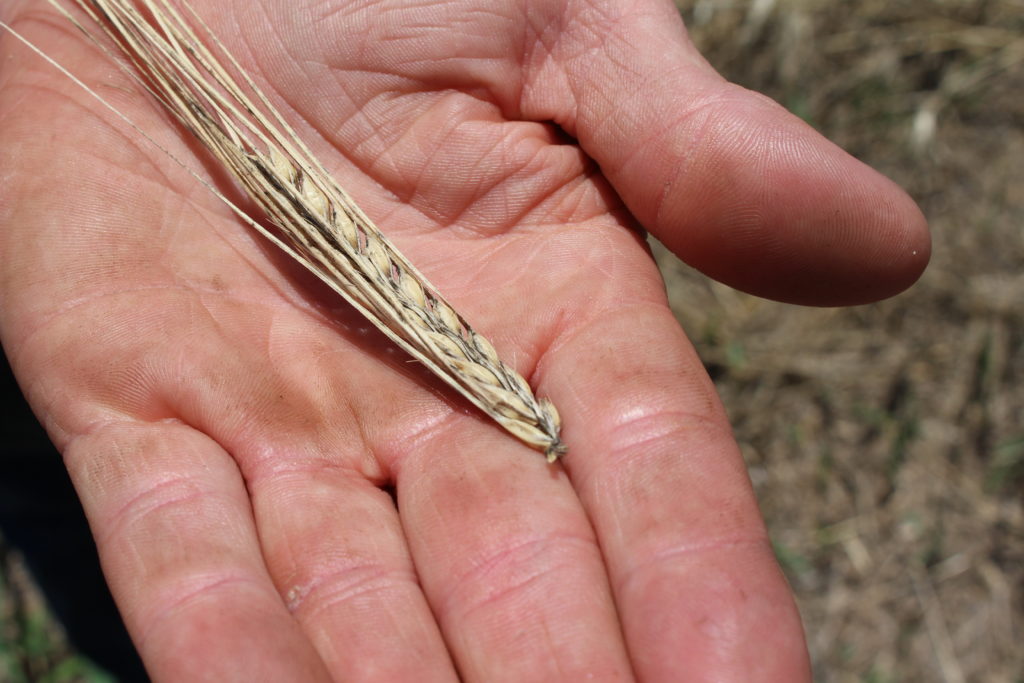Farm & Ranch
All about the Tiny Bits of Barley

By Jessica Crabtree
As the summer temperatures of June began to steep, you could find the Fortenberry brothers busy at work hauling hay from the field. The brothers are eighth generation farmers and ranchers, of the progressive kind. With degrees from Texas A&M, the Fortenberrys are constantly looking to elevate their farming practices. Entrepreneurs in their young age, their latest endeavor is barley.
The first year for the Fortenberry is seen as a trial and error year: time to evaluate what worked and what didn’t, in order to move on next year. With barley there are two classes, food consumption grade and feed grade. The brothers are aiming for the food consumption grade in order to malt their barley harvest.
Barley is typically used as a source of fermentable material for beer and certain distilled beverages and as a component of various health foods. You also see it used in soups and stews, in bread among various cultures, as well as in cattle feed. “With this we are still looking for plumpness of the grain and weight of bushel, but we are also after a lower protein percentage. Basically, the lower the quality the better,” Ethan Fortenberry said. Not a normal crop for the North Texas region, barley is typically grown in dryer climates such as in Idaho, Colorado, Wyoming, Wisconsin and in the Dakotas.
The farmers shared they planted their barley in October, very similar to wheat, while those up north plant their barley in February or March as more of a spring crop.”Here [Slidell] we have kind of less than favorable soil with a lot of rock,” Bain Fortenberry said. The two explained other places may add more nitrogen or irrigate to manipulate the crop for more yield, saying, “Target expected return with nitrogen.” With barley used for malting, the ideal protein percentage is 10.5 to 11 percent. However, more than 12 is not acceptable. If protein in the barley tests too high, it is simply sold for feed.
To read more pick up a copy of the August 2017 issue. To subscribe call 940-872-5922.
Farm & Ranch
Managing Show Cattle Through The Winter

By Heather Welper
Husband and wife duo, Heather and Calvin Welper, are the Co-Owners and Operators or Two C Livestock, located in Valley View, Texas.
The pair’s operation has a show cattle focus where they raise and sell purebred heifers of all breeds and club calf Hereford steers.
When it comes to show cattle, the Welpers know a thing or two including how to prepare for the cold winter months and the Texas major show season run.
To read more, pick up a copy of the November edition of North Texas Farm & Ranch magazine, available digitally and in print. To subscribe by mail, call 940-872-5922.

Farm & Ranch
Double M Ranch & Rescue

By Hannah Claxton, Editor
As the sun rises each day, so do the dozens of mouths that Meghan McGovern is responsible for getting fed. Rather than the sounds of a rooster crowing, McGovern hears the bellows and bleats of a variety of exotic deer, the chortle of kangaroos, the grunts of water buffaloes, and the chirps of a lemur.
Nestled against the banks of the Red River, the Double M Ranch and Rescue, with its high game fences and deer sprinkling the landscape,s its in stark contrast to the surrounding ranches.
“Having deer is kind of like eating potato chips- you can never actually have just one,” said McGovern with a laugh.
McGovern has several herds to take care of- fallow deer, axis deer, water buffalo, goats, and bison. In smaller numbers, there’s also a few kangaroos, a lemur, a potbelly pig, a pair of zebras, a watusi, and a few horses.
To read more, pick up a copy of the November edition of North Texas Farm & Ranch magazine, available digitally and in print. To subscribe by mail, call 940-872-5922.

Farm & Ranch
Acorn Toxicity

By Barry Whitworth, DVM, MPH
With the prolonged drought, most pastures in Oklahoma end up in poor condition. With the lack of available forage, animals may go in search of alternative foods.
If oak trees are in the pastures, acorns may be a favorite meal for some livestock in the fall. This may result in oak poisoning.
Oak leaves, twigs, buds, and acorns may be toxic to some animals when consumed.
To read more, pick up a copy of the November edition of North Texas Farm & Ranch magazine, available digitally and in print. To subscribe by mail, call 940-872-5922.

-

 Country Lifestyles2 years ago
Country Lifestyles2 years agoScott & Stacey Schumacher: A Growth Mindset
-

 Country Lifestyles8 years ago
Country Lifestyles8 years agoStyle Your Profile – What your style cowboy hat says about you and new trends in 2017
-

 HOME8 years ago
HOME8 years agoGrazing North Texas – Wilman Lovegrass
-

 Outdoor10 years ago
Outdoor10 years agoButtercup or Primrose?
-

 Country Lifestyles5 years ago
Country Lifestyles5 years agoAmber Crawford, Breakaway Roper
-

 Country Lifestyles9 years ago
Country Lifestyles9 years agoJune 2016 Profile – The man behind the mic: Bob Tallman
-

 Country Lifestyles8 years ago
Country Lifestyles8 years agoDecember 2016 Profile, Rusty Riddle – The Riddle Way
-

 Equine1 year ago
Equine1 year agoThe Will to Win





